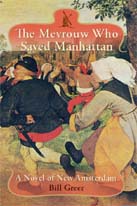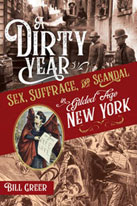Sex and the City: The Early Years
A Bawdy Look at Dutch New York
Part 2 of 3
Go to: Part 1 - Part 2 - Part 3
[Full story also available as a PDF download]
A Bawdy World
TO EUROPEANS OF THE ERA, Griet’s outrageous ways simply reflected the loose morals of Dutch society during the seventeenth century, in what is known as the Golden Age of the Netherlands, the most prosperous country in Europe at the time.
The Dutch certainly had a fondness for beer. If a Dutchman had no drinking partner, observed one traveler in Holland, he would choose his own hat or coat as a boon companion and drink himself so silly that he reached the same level of reason as the hat or the coat. Dutch women outnumbered their men because they drank so much that they couldn’t beget boys, argued an English visitor.
The Dutch more or less agreed. “Beer and wine certainly weren’t brewed for the geese,” they said. “So let us use it to our hearts’ content.”
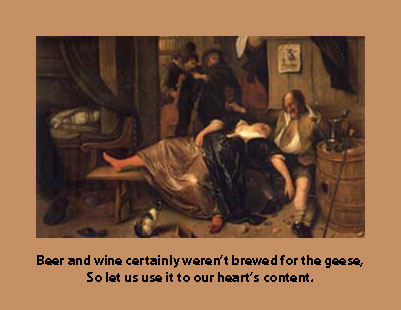 Gambling went hand in hand with drinking. Pass-ten was a popular dice game in which each player rolled the dice from a glass appropriated as the shaker. A man immediately downed as many drinks as the number he had thrown. A woman immediately gave her fellow players kisses totaling her roll. One preacher thundered against the scene around the card table: “Young girls got up like dolls, with shameful hair-styles, their necks, shoulders and bosom bare, offering to young men a spectacle of sinful flesh which tempts them to stray in the paths of their own hearts and amid the impure visions of their eyes, contaminated by disgusting pleasures, forgetful that one day they will have to appear before their judge.”
Gambling went hand in hand with drinking. Pass-ten was a popular dice game in which each player rolled the dice from a glass appropriated as the shaker. A man immediately downed as many drinks as the number he had thrown. A woman immediately gave her fellow players kisses totaling her roll. One preacher thundered against the scene around the card table: “Young girls got up like dolls, with shameful hair-styles, their necks, shoulders and bosom bare, offering to young men a spectacle of sinful flesh which tempts them to stray in the paths of their own hearts and amid the impure visions of their eyes, contaminated by disgusting pleasures, forgetful that one day they will have to appear before their judge.”
That preacher was on the right track for fervor for sex played second fiddle to neither beer nor games of chance. When asked whether it was better to make love in the morning or evening, a Dutch doctor concluded it was no doubt better on the digestion to have your poke in the a.m.. But it was more fun in the p.m., so why not do it in the morning for health and in the evening for pleasure?
If a Dutchman was looking for new ways to pleasure his mate, he found a copy of Venus Minsieke Gasthauis, an extraordinarily frank sex manual that went through seven printings during the seventeenth century. Don’t over do it, the manual warned. Four or five ejaculations a night is all a man’s health can endure. Indulge more often and your semen will lose its fertility. And don’t come at your beloved from behind, humping like a wild beast.
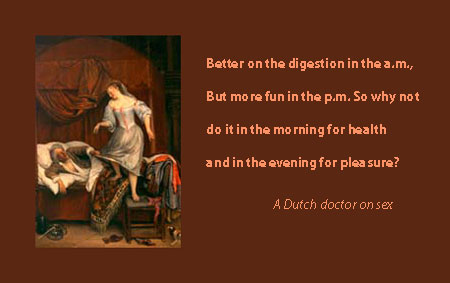 Women got much of the blame for throwing inhibitions to the wind. A nubile maiden was like a chestnut on the fire, sure to explode if not cooled down. Sex before marriage was known as a “premature conversation,” and plenty of couples started early. A couplet about the goings on at peasants’ festivals describes the loose behavior: There people recklessly make a mixed bed / That is, a net for catching virgins.
Women got much of the blame for throwing inhibitions to the wind. A nubile maiden was like a chestnut on the fire, sure to explode if not cooled down. Sex before marriage was known as a “premature conversation,” and plenty of couples started early. A couplet about the goings on at peasants’ festivals describes the loose behavior: There people recklessly make a mixed bed / That is, a net for catching virgins.
The devil was conspiring to ruin the Fatherland by luring serving girls to all kinds of moral iniquity, according to “The Seven Devils Ruling Present-Day Maidservants,” a 17th century satire. Widowers were particularly vulnerable to seduction by their maids, a folly described as “a man shitting in his own hat and then setting it on his head.” Said a maid about her morals, “It costs so much to keep your honor. I’m glad I’m well rid of mine.”
So the people of Manhattan came by their bawdy character honestly. As New York’s earliest whore, Griet wasn’t the only person who earned a place in the early annals of Sex and the City.
An Early Member of Manhattan’s Gay Community
HARMEN VAN DEN BOGAERT ARRIVED in Manhattan about 1630 at the tender age of eighteen. He was New York’s first surgeon, barber too for in those days the person who deloused your hair also bled you when you took sick.
For nearly twenty years, Van den Bogaert was a respected citizen about town. He owned a house on Stone Street, called Brouwer in those days for the breweries that lined it. His wife Jelisje bore him four children. Along with other town leaders, Van den Bogaert invested in the La Garce, a privateer raiding Spaniards in the Caribbean. So what the wars with Spain had ended, there was money to be made.
In 1634, Van den Bogaert was named an ambassador to the Mohawks. In the middle of winter, he and two companions set off on the arduous journey into Mohawk country. Their assignment was to restore the fur trade, disrupted by what the Mohawks considered prices that cheated them out of their beaver and a crooked head of the Dutch trading post at Fort Orange, today’s Albany. Frenchmen eager to claim the fur trade for themselves stirred the Mohawk’s anger. By all accounts, the mission was a success, and in the bargain, Van den Bogaert left us a journal that sheds much light on the life of the Indians he visited.
But in 1647 upriver at Fort Orange, Van den Bogaert was discovered in what the Dutch considered an unnatural position with a young boy named Tobias. The offense was a capital crime. Two sailors caught buggering aboard ship would be tied together and cast overboard. Even a powerful business or social position was no guarantee of safety. Justus Schouten was a leading official in the East Indies when he was found in flagrante with a young native. Despite his connections as a close advisor to the Governor-General in Batavia, he was burned at the stake.
Realizing the fate awaiting him, Van den Bogaert fled to his friends the Mohawks. Chasing after, a Dutchman cornered him in a Mohawk longhouse. Van de Bogaert set the longhouse afire, but the conflagration did not help him escape. He was hauled off to jail.
The new Director Peter Stuyvesant promised to come to Fort Orange when the ice broke on the river. He would personally pass sentence on the criminal, and he was not a man from whom anyone should expect mercy. Desperate, Van den Bogaert broke out of his prison. But his luck had run out. As he scampered across the frozen river, the ice cracked. Sucking its victim into its icy flow, the river carried out the capital sentence.
Lest anyone think Stuyvesant might have shown mercy, some years later Jan Quisthout van der Linden was caught sodomizing an orphan boy placed with him as an apprentice. He was tied in a sack and drowned. Being the victim was not punishment enough for the orphan either. He was whipped.

The Adulteress
NANNE BEECH DIDN’T LET MUCH get in the way of her fun, least of all her husband. In 1638, the still-closeted Van den Bogaert observed her at a neighbor’s house “appearing merry.” Strong drink making her frisky, Nanne spent the evening fumbling at the breeches of all the men present. Her husband Thomas begged her to come home, but she was not to be persuaded.
That particular evening was a relatively innocent one for Nanne. Not so another night when Nanne opened her home to two guests, Edward Wilson and Francis Lastley. According to Wilson, Nanne offered a little too much hospitality to Lastley.
Proclaiming her innocence, Nanne, or perhaps her husband Thomas, sued Wilson for slander. Wilson testified he was sick abed while staying with the Beeches. Thomas was out hunting. Feeling lonely, or taking advantage of a good situation, Nanne cosied up to Lastley. As their affections progressed, Nanne called out three times to make sure Wilson was asleep. He pretended to be. But he kept one eye cocked open as Nanne lay upon the bed with Lastley, manipulating his “male member” and engaging in “carnal conversation.”
No word survived on how the court decided the slander case. But Thomas took his wife’s adulterous ways hard. In a very depressed state a year later, Thomas declared he should not live another fortnight, or a month at the longest. His prophecy proved true. Within a year, Nanne had captured a second husband.
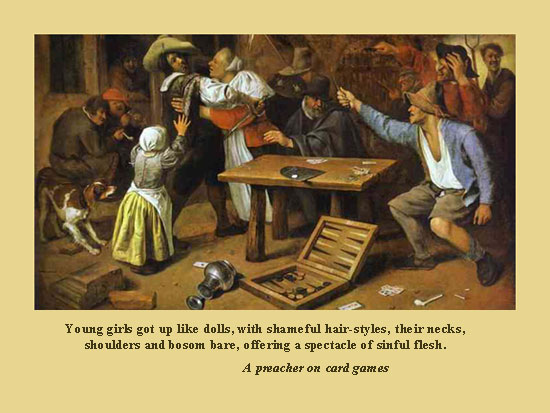
The Cuckold
Joost Goderis learned the hard way that trouble in the marriage bed could be no private matter in New Netherland. Returning from a day of oystering near Ellis Island, Goderis was met by a group of men who’d taken an interest in his wife. Claiming that one of the town’s schepens, Allard Anthony, had had the woman on her back, they called out Goderis ought to wear horns like cattle in the woods. One went so far as to ask Joost to permit him to lay where Allard lay, to have sexual connection with the lady himself. Blows soon followed and before the melee ended, Goderis suffered not only the humiliation of being one of New York’s early public cuckhold’s but a sliced neck as well.
The Jilted Woman
GRIETJE WESTERCAMP WAS A GOOD GIRL, really she was. She loved Pieter Jacobsen, but she wasn’t throwing her virginity away until she got the promise. Say you’ll marry me, then you can enjoy my pleasures, she told him. He promised, Grietje testified before the court. He is the father of my baby. Make him marry me.
The judges looked at Pieter. A promise of marriage made in the Eyes of God shall remain in force, they ruled.
But I never promised, Peter swore. Grietje Westercamp is a loose woman. She lay under the blanket with Jan van Breeman, and with his daughter in bed beside them.
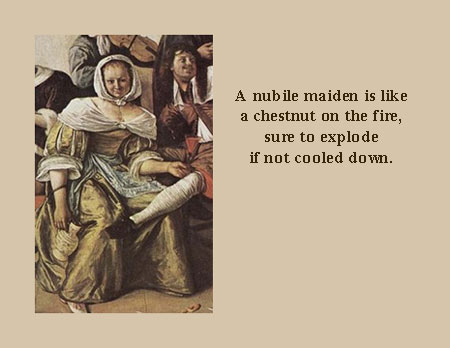 Juriaen Westvael and his wife backed up Pieter’s story, in return for a few coins Grietje believed. The judges pressed Pieter. Did you not enjoy Grietje’s pleasures? Did you not promise to marry the girl?
Juriaen Westvael and his wife backed up Pieter’s story, in return for a few coins Grietje believed. The judges pressed Pieter. Did you not enjoy Grietje’s pleasures? Did you not promise to marry the girl?
Pieter finally broke under the interrogation. One time, he admitted, one time I lay with the plaintiff. But, he asked, looking at the pregnant girl, how can a woman be thirteen months in the family way? He wasn’t the father and he had never uttered a word about marriage. Where was her proof?
Proof? the judges asked. Did Grietje have her promise in writing? Or could she bring witnesses who had heard Pieter say it, and had the couple exchanged gifts? That would be binding.
Poor Grietje had neither paper, gifts nor witnesses. The court could not force the marriage without proof of the promise.
But he admitted he lay with me, Grietje protested.
True, the judges decided. Pieter has acknowledged a time he lay with the girl and he is bound to pay her for that service. Two hundred guilders.
At least the judges treated Grietje better than a common whore. Two hundred guilders was far above the going rate.
A Bigamist and an Embezzler
CORNELIS VAN TIENHOVEN WAS AN important man. He came as a clerk, but Director Kieft promoted him to Secretary, a powerful position responsible for recording land deeds and marriages, taking depositions, keeping minutes for the Director’s Council, collecting taxes.
Being a compatriot of Kieft and supporting the Director’s Indian wars made Van Tienhoven none too popular. He wasn’t an appealing man to start with, being rather corpulent with a red and bloated visage. He was known for chasing Indian women wearing nothing but a patch over his loins and his lust showing through. Meanwhile his wife Rachel sat at home raising the children.
When Peter Stuyvesant took over, Van Tienhoven retained his position as Secretary. In 1650, he returned to Holland to defend Stuyvesant against accusations of tyranny. He grew lonely with his wife so far away so he took up with a basket maker’s young daughter named Lysbeth.
The girl’s widowed mother was none to happy about the arrangement. The couple ran away. They secretly set up house together at a tavern called The Three Doves. Upon the proprietor raising questions, Van Tienhoven admitted he and Lysbeth weren’t married, merely engaged. He intended to wed her as soon as they returned to New Amsterdam.
Lysbeth believed his promises. The sheriff did not. He caught up to the couple, but Van Tienhoven bought him off. With the heat upon him, Van Tienhoven decided he better ignore the orders not to leave Holland without official permission. He and Lysbeth slipped aboard a ship bound for New Amsterdam.
Unfortunately for Lysbeth, Van Tienhoven’s wife Rachel waited on the Manhattan shore, dissolving the poor girl’s engagement but saving Van Tienhoven from becoming New York’s first bigamist.
The man still had a first in him, however. Upon his return, Van Tienhoven wormed his way back into all Stuyvesant’s business, only to be discovered with his fingers in the till. New York had found its first embezzler, or at least first caught red-handed.
Shortly thereafter, Van Tienhoven’s hat and cane were found floating in the river. Stuyvesant declared he had drowned. Most people believed Van Tienhoven had absconded to the Caribbean with the embezzled funds.
Two Deviants
WILLEM GILFOORT ATTAINED HIS NOTORIETY in 1648 when he ran across 11-year old Maria Barents. The girl’s mother had unwisely let her wander off alone. Gilfoort scooped the child up and threw her into the cellar of a neighbor’s house.
Climbing in after, the man untied his breeches and jumped atop Maria. For a quarter hour, he tried to have carnal conversation with her.
Gilfoort was charged as New York’s first child molestor. But poor Maria was too young for Gilfoort to achieve his desired penetration, the court ruled. It sentenced him to flogging and banishment. A punishment lighter than the man deserved, the court noted, but it justified the leniency on the grounds that shortly after Gilfoort’s act, Maria willfully consented to conversation with one Willem Wessels. Ready or not, the girl was starting young.
New York’s first schoolmaster, Adam Roelantsen, was known for poking his nose into other people’s business. Seeing how much fun others were having, he decided to claim his own on a visit to Harck Syboltsen. Harck wasn’t home but when his wife Mevrouw Teunes answered the door, Roelantsen pushed in and proceeded to violate the poor woman, or try to. When he was hauled into court on a charge of rape, he admitted to fondling the woman’s naked breasts. With marks of his attack still visible on her body, Roelantsen was condemned to be flogged and banished as an example to others.
Director Kieft, however, took pity on Roelantsen’s four children who had lost their mother, and with a cold winter approaching, he postponed the sentence to a more suitable opportunity which evidently never arrived.
Go to: Part 3
Bill's Books
The Mevrouw Who Saved Manhattan
A Novel of New Amsterdam by Bill Greer
A "romp through the history of New Netherland that would surely have Petrus Stuyvesant complaining about the riot transpiring between its pages ... Readers are guaranteed a genuine adventure that will evoke the full range of human emotions. Once begun, they can expect to experience that rare difficulty in putting down a book before they have finished."
-- de Halve Maen, Journal of the Holland Society of New York
About the Book
_________________________
A DIRTY YEAR
Sex, Suffrage & Scandal in Gilded Age New York
A nonfiction narrative of 1872 New York, a city convulsing with social upheaval and sexual revolution and beset with all the excitement and challenges a moment of transformation brings.
From Chicago Review Press, 2020
More on the Book
